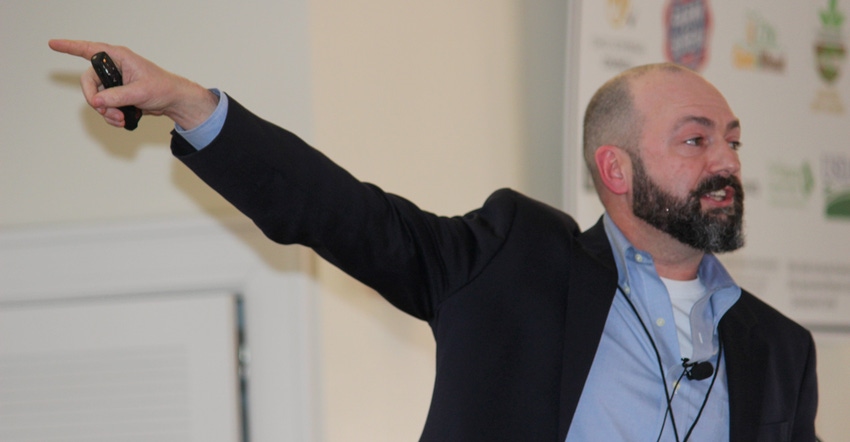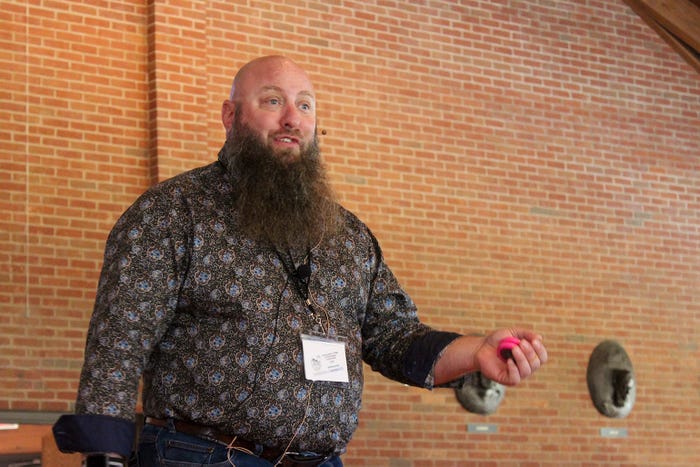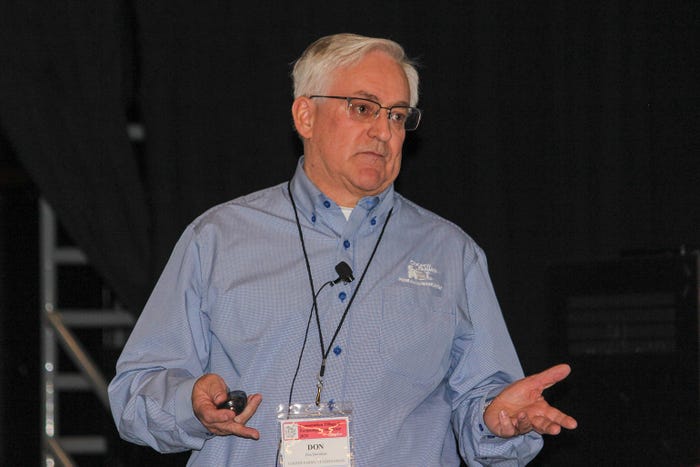
The Conservation Tillage and Technology Conference held recently at Ohio Northern University in Ada, gave the 800-plus participants a look at conservation research efforts around the country, as well as a variety of locally based management recommendations.
In addition to farmers, the annual conference attracts many certified crop advisers, who carry what they learn to additional farmers, noted Randall Reeder, a retired Ohio State University Extension ag engineer. Reeder helps coordinate the conference, which is organized by OSUE, the Ohio Agricultural Research and Development Center, northwest Ohio soil and water conservation districts, the Ohio No-Till Council, USDA Farm Service Agency, USDA Natural Resources Conservation Service and the Ohio Department of Agriculture.
Each certified crop adviser, on average, works with about 30,000 acres, so reaching 300 CCAs through the event extends the conservation message to millions of acres, Reeder pointed out.
This year was the 28th year for the two-day conference, which featured more than 60 presentations and dozens of trade show exhibits. Here’s a sampling of the topics discussed.
The limits of grids
Agricultural engineers have done a good job developing equipment to apply nutrients precisely, but the grid-based soil tests often used to guide applications don’t offer the same precision, according to Josh McGrath, an ag soil management specialist with the University of Kentucky. “We didn’t pay attention to the fact that interpolation doesn’t work,” he explained.
To set rates for variable-rate applications, producers often take soil samples using a grid system, and then interpolate the nutrient levels for areas of the field between soil test points. The problem is that estimating unknown values between sampling points only works if the sampling points are close enough together that they are correlated, he said. However, researchers are finding that samples would need to be taken on grids of a quarter-acre or smaller to have that correlation, McGrath explained. Field averages are often closer to the true values than the interpolated estimates for any particular spot.
Producers who have used grid-based systems have found the systems work, meaning they allow for overall reductions in fertilizer use without hurting yields. McGrath attributed that success to the “safety factors” built into fertilizer recommendations. Even though application rates were reduced for areas of a field, they never went below optimal yield rates, he said. “It was blind luck it looked like it worked.”
The problem isn’t the grid-based approach to soil testing, it is the interpolation of data, he stressed. He recommended investing in more frequent sampling, rather than focusing on a grid approach. For those who are using grids, he suggested shifting the grids over time to get a denser sample map.
McGrath said he favors developing new research design and analysis methods to get more precise application recommendations to go with the existing precision application equipment. He’s studying zone sampling, he said, using topography, soil texture and previous grid samples to outline management zones. Yields can be used to test zones, but not necessarily to create them, he added.
He and other researchers at the University of Kentucky are in the process of developing free software to use in developing zones, he noted. He hopes to have it available online by the end of the year.
 DETAIL-ORIENTED: Lee Briese, a certified crop adviser from North Dakota, uses a yo-yo to illustrate his approach to the challenges of conservation.
DETAIL-ORIENTED: Lee Briese, a certified crop adviser from North Dakota, uses a yo-yo to illustrate his approach to the challenges of conservation.

Matching cover crops and herbicides
Herbicide carryover can cause problems for establishing cover crops, so plan ahead, advised Lee Briese, a CCA from North Dakota and the 2017 International Crop Adviser of the Year. He encouraged participants to pay attention to details during his keynote address, and he then focused on some of those details during additional sessions.
For Briese, herbicide selection takes precedence over selection of cover crop species. “I fit the cover crops into the herbicides,” he explained. Failing to control an insect or disease will affect the current year, but may or may not cause problems in future years. Weeds, on the other hand, can put out seeds that can become an ongoing problem, he said. “If you miss a weed, how many years will that be a problem? Decades.”
In some cases, it makes sense to go after problem weeds, even if the herbicide being used damages the cover crop, he added. “A little bit of injury on a cover crop is probably tolerable. A little bit of a stand loss is probably tolerable.”
If cover crops will be harvested or used for forage, he advised keeping in mind the herbicide label restrictions. They’re not just recommendations — they are the law, he stressed. “If you’re going to put it in the food system or run it through livestock, you might have issues.”
If herbicide tolerance information for a particular species of cover crop is not listed, consider the plant family and related crops, Briese suggested. For instance, dicamba has poor kill performance on mustard and a short plant-back period for canola. So, the risk would likely be low for using it prior to planting another brassica species, such as radishes.
Jeff Stachler, OSUE educator for Auglaize County, also discussed setting up herbicide programs with cover crops. Moisture and temperature influence both the microbial and chemical breakdown of herbicides, he pointed out. Cooler weather and dry conditions inhibit activity. Soil composition can also influence breakdown rates.
Stachler said he recommends researching herbicides to avoid interactions with cover crops and keep from violating label restrictions on grazing. “You have to understand what active ingredients are in your herbicides so you don’t make a mistake.” For instance, the ingredient imazethapyr has extra-long rotation restrictions: 40 months for radish, kale, rape, mustards, turnip and buckwheat; and 18 months for oats, sunflowers and sorghum. It’s an ingredient in several herbicides including Pursuit, Authority Assist and Matador.
 BIOSECURE: Don Davidson, a veterinarian with Cooper Farms, discusses the challenges of managing manure and maintaining biosecurity to prevent spread of livestock diseases such as porcine reproductive and respiratory syndrome and African swine fever.
BIOSECURE: Don Davidson, a veterinarian with Cooper Farms, discusses the challenges of managing manure and maintaining biosecurity to prevent spread of livestock diseases such as porcine reproductive and respiratory syndrome and African swine fever.

Disease defense
While the public has recently become more aware of disease spread due to COVID-19 concerns, the agricultural industry has ongoing efforts to keep livestock diseases such as African swine fever (ASF) from spreading through the country. Don Davidson, a veterinarian with Cooper Farms, a diversified farm company based in northwest and western Ohio, said it’s likely ASF is already in the United States, but it has not yet made its way to hogs here. It can be carried by smuggled food products, he explained. Studies have shown it can survive 1,000 days in frozen pork. “That’s when they stopped the study,” he noted, adding that it’s likely the virus can survive indefinitely in frozen meat. It can also be transmitted through contaminated feed.
Transmission by feral hogs is a concern as well, Davidson added. ASF has been found in Poland, so Germany has tried putting up fences to keep feral hogs from crossing the border. “You know how pigs and fences are, so it’s not working too well,” he noted.
Only a small amount of manure contaminated with a virus can cause transmission, he stressed.
To guard against ASF, Davidson says producers should use the same biosecurity measures they are already using to prevent the spread of porcine reproductive and respiratory syndrome (PRRS) and porcine epidemic diarrhea virus (PEDV). That means cleaning vehicles, boots and clothing to keep from carrying manure containing viruses into livestock facilities, he said, adding that when manure is being pumped, extra care is needed to maintain a line of separation. “Biosecurity does work,” he stressed.
 CAFO CONCERNS: Sam Mullins, chief of the Ohio Department of Agriculture’s Livestock Environmental Permitting Division, points out the most common causes of manure application violations for concentrated animal feeding operation (CAFO) permit holders.
CAFO CONCERNS: Sam Mullins, chief of the Ohio Department of Agriculture’s Livestock Environmental Permitting Division, points out the most common causes of manure application violations for concentrated animal feeding operation (CAFO) permit holders.

CAFO update
The Ohio Department of Agriculture is currently reviewing the rules for the Livestock Environmental Permitting Program (LEPP) and some changes might be on the way within the next couple of years, according to Sam Mullins, chief of the Ohio Department of Agriculture’s Livestock Environmental Permitting Division. The department has received requests from the public to begin permitting medium-sized operations as well as concentrated animal feeding facilities (also called concentrated animal feeding operations, or CAFOs), but that would not be practical with the existing staff, he noted. The staff would need to be quadrupled to cover that many operations.
Manure handling problems are not widespread among the state’s CAFOs, Mullins said, but there are some opportunities for improvement. “We are still seeing issues where manure is land-applied, and the soil test is not consulted.”
Another concern is soil conditions, Mullins said. “The big one that we’re missing is soil capacity.” Monitoring tile outlets is one way of evaluating capacity, he said. If the tile is flowing, the field is likely at capacity already, and the soil won’t have the ability to absorb manure liquid. Producers sometimes ask how long they need to monitor tile outlets, but there is no specific time limit, he added. “It’s until that manure is assimilated into the soil.”
Manure sampling is also sometimes a concern, he added. Different barns at the same farm can show different manure analysis results, which can be affected by agitation and stratification.
Maintaining required setbacks is important as well, Mullins noted. Satellite images make it easier to see when applications are made in setback areas or on waterways. “We’re using Google Earth every single day,” he said. He’s not seeking out that information to catch violators, but to help producers improve their management, he explained. “I can use this as an educational opportunity.”
Keck writes from Raymond, Ohio.
About the Author(s)
You May Also Like




